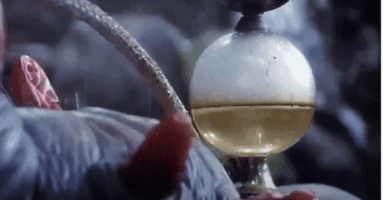This Year’s Ig Nobel Winners Are Awesomely Ridiculous–And Ridiculously Awesome
This article is more than 2 years old

The awards are given by an organization called Improbable Research, which also publishes a magazine called the Annals of Improbable Research. The Ig Nobels honor the best of this kind of study. This year, the winners really ran the gamut (as they always do), offering research on everything from how reindeer respond to humans masquerading as polar bears to the cognitive processes of people who see Jesus in their toast. I’m pretty sure I’ll never write another sentence quite as interesting as that one.
It seems silly to start anywhere but the Jesus toast, so here goes. Kang Lee is a psychologist from the University of Toronto who has been fascinated by the subject of face pareidolia, which is when people believe they see Jesus or Mary or whomever on their toast or tortilla or in the clouds. People who claim to see these images are often mocked and/or thought to be a little unhinged, but Lee’s research supports the idea that this phenomenon is actually pretty common and is due to the brain’s wiring, not to an individual’s grip (or lack thereof) on reality. His study suggests that people’s brains are specially wired to identify faces. The frontal cortex, which is the part of the brain responsible for our expectations, communicates with the posterior visual cortex, which connects expectation with reality—in this case, melding external stimuli into something familiar. People’s expectations can actually dictate what they see. According to Kang, “believing is seeing.”
 One winner that particularly resonates with me is about the “relationship between cat bites and human depression.” This study relied on data mining, and then attempted to correlate the results. The sample size was 1.3 million patients, 750 of whom had cat bites, 1108 of whom had dog bites, and 117,000 of whom were depressed. Of the patients with cat bites, 41.3% suffered from depression, while only 28.7% of the dog-bitten patients did. Interestingly, 85.5% of the patients with both cat bites and depression were females (64.5% of the patients with cat bites and depression were women). Crunching the numbers reveals that a woman bitten by a cat had a 47% chance of being diagnosed with depression if she got bitten by a cat. Huh. The study admits that there’s no causal link between the data—it can’t prove that owning a cat or getting bitten by a cat actually causes depression, although I think it’s reasonable to assume that if you own a cat who’s enough of an asshole to really bite you, you either don’t or won’t feel awesome.
One winner that particularly resonates with me is about the “relationship between cat bites and human depression.” This study relied on data mining, and then attempted to correlate the results. The sample size was 1.3 million patients, 750 of whom had cat bites, 1108 of whom had dog bites, and 117,000 of whom were depressed. Of the patients with cat bites, 41.3% suffered from depression, while only 28.7% of the dog-bitten patients did. Interestingly, 85.5% of the patients with both cat bites and depression were females (64.5% of the patients with cat bites and depression were women). Crunching the numbers reveals that a woman bitten by a cat had a 47% chance of being diagnosed with depression if she got bitten by a cat. Huh. The study admits that there’s no causal link between the data—it can’t prove that owning a cat or getting bitten by a cat actually causes depression, although I think it’s reasonable to assume that if you own a cat who’s enough of an asshole to really bite you, you either don’t or won’t feel awesome.
I was happy to see that GFR had previously covered one of the winners—a study about how dogs line up with the Earth’s geomagnetic field when they crap. But I’m sorry we missed the one about folks dressing up as polar bears to test reindeers’ reactions. That study was trying to gain insight into the interactions between reindeer and polar bears in the Arctic. As temperatures climb, polar bears are widening their territory in search of food, and it turns out that people dressed as polar bears scared the reindeer less than people dressed in dark-colored hiking clothes.
These recipients are just the tip of the iceberg. You can find a full list of the winners HERE, all of which fulfill the “laugh then think” mandate.












